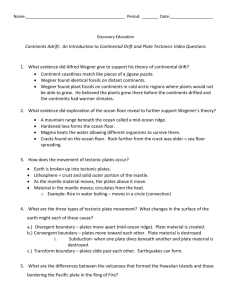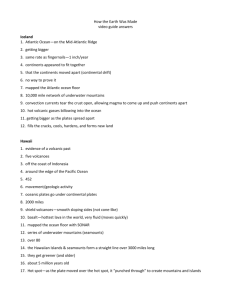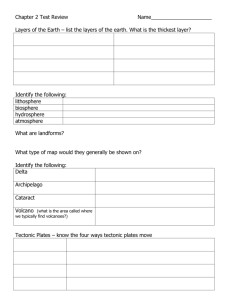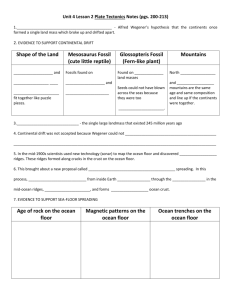File - Mr Schmitt
advertisement
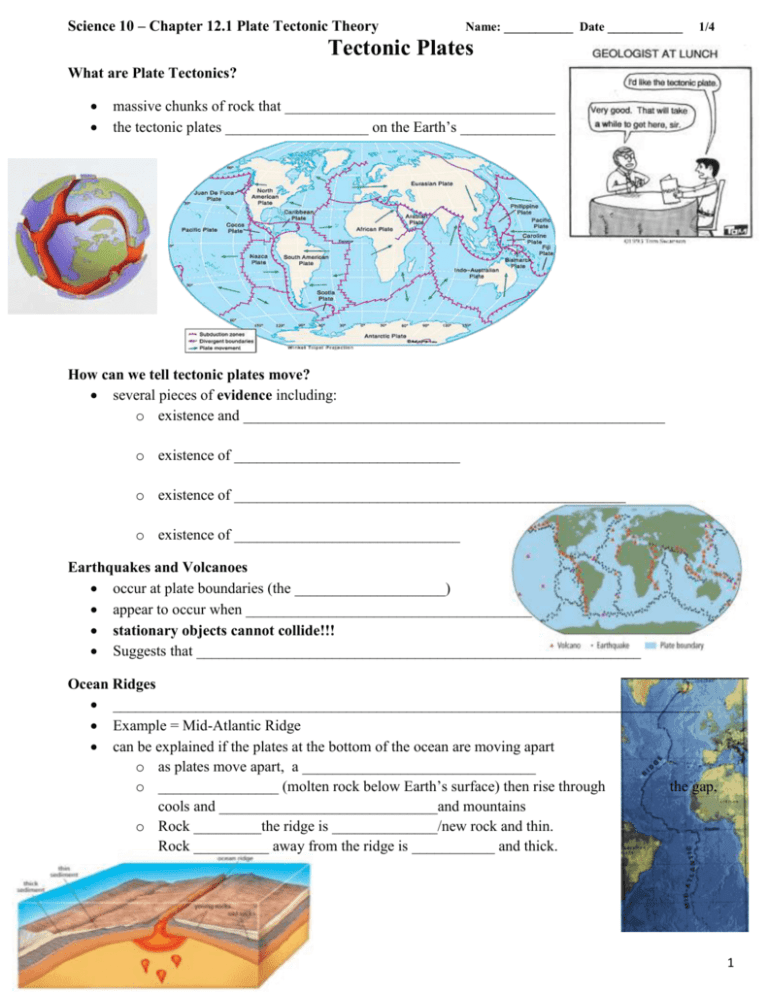
Science 10 – Chapter 12.1 Plate Tectonic Theory Name: ___________ Date ____________ 1/4 Tectonic Plates What are Plate Tectonics? massive chunks of rock that _________________________________________ the tectonic plates ___________________ on the Earth’s _____________ How can we tell tectonic plates move? several pieces of evidence including: o existence and ________________________________________________________ o existence of ______________________________ o existence of ____________________________________________________ o existence of ______________________________ Earthquakes and Volcanoes occur at plate boundaries (the ____________________) appear to occur when ______________________________________ stationary objects cannot collide!!! Suggests that ___________________________________________________________ Ocean Ridges ______________________________________________________________________________ Example = Mid-Atlantic Ridge can be explained if the plates at the bottom of the ocean are moving apart o as plates move apart, a _______________________________ o ________________ (molten rock below Earth’s surface) then rise through the gap, cools and _____________________________and mountains o Rock _________the ridge is ______________/new rock and thin. Rock __________ away from the ridge is ___________ and thick. 1 Science 10 – Chapter 12.1 Plate Tectonic Theory What is magnetic striping? – (Paleomagnetism evidence) Name: ___________ Date ____________ 2/4 _____________________ at the bottom of the ocean that have alternating __________________ Magnetic striping can be explained if the ________________________ as the Earth’s _____________________________________ Sea floor spreading ocean ridges and magnetic striping suggest that the ________ _______________________________or moving apart in other words, the _________________________________ Volcanic Island Chains are __________________ that are formed when ________ reaches the Earth’s surface and _____ can be explained if plates move over a ______________ hotspots = an area where ________________________________________________________ cools and forms new rock . hotspots are _________________________ in the Earth’s molten core as the plate moves, the _____________________________ as a new portion of the _________________________________________________________ until eventually you get a chain of islands For example, the Hawaiian Islands form as the Pacific Plate moves North East over a hot spot\ Typically, _____________________________________ because the older island has been eroded away over time by the ocean and weather. 2 Science 10 – Chapter 12.1 Plate Tectonic Theory Name: ___________ Date ____________ Summary of evidence that suggests that tectonic plates can move Earthquakes and Volcanoes ___________________________________________ Ocean ridges _______________________________________________________________ Magnetic stripes ____________________________________________________________ Island chains___________________________________________________________ 3/4 Plate Tectonic Theory is a unified theory that came out of the above evidence states that the ________________________________________________________________ that float and continually _________________________________________________________ came about _____________________________ Wegener’s Continental Drift Theory o supported Wegener’s theory as it _________________________________________________ finally silenced Wegener’s critics because he now had evidence to suggest that the continents were once together in a supercontinent (jigsaw puzzle fit of continents, fossils, geological structures, paleoglaciation and coal deposits) and evidence to support/explain how continents could drift (plate tectonics) 1. Plate tectonics refers to the fact that the surface of Earth is broken into several large "plates" which ride along on what resembles a giant conveyer belt of rock. Using this analogy, what would be the beginning of the conveyer belt? A. B. C. D. Tectonic plate edges Hot spots Ocean ridges Earthquakes 2. Which of the following is not a piece of evidence to support plate tectonics? A. B. C. Sediments on the ocean floor are much thicker close to ocean ridges than near continents Long stripes of iron-rich basalt rock with reversing polarity run parallel to ocean ridges Ocean floor samples taken near oceanic ridges is much younger than ocean floor samples taken near continents D. Much of Earth's volcanic and earthquake activity occurs along the boundaries of tectonic plates 3. Which part of the plate tectonic theory explains what actually makes the plates move? A. B. C. D. Volcanoes Sea floor spreading Paleomagnetism Earthquakes 3 Science 10 – Chapter 12.1 Plate Tectonic Theory Name: ___________ Date ____________ 4/4 4. The Hawaiian Islands formed over a hot spot in the ocean floor. Which direction is the ocean floor moving in this location? A. B. C. D. Southwest Southeast Northwest Northeast 5. New rock is created at ocean ridges, pushing the older ocean floor away from the ridge. What causes the new rock to form? A. B. C. D. Convection currents in the magma below the ocean floor Volcanic eruptions Earthquakes in the ocean crust Movement of the ocean crust over hot spots 6. The theory of continental drift named a key part of this idea Pangaea. What is Pangaea? A. One of the ancient animals that helped Wegener prove that fossils from different continents originally came from the same location B. The hot spot which gave rise to the Hawaiian Islands, among others C. The underwater ocean range in the middle of the ocean D. A supercontinent that existed in Earth's distant past Chapter 12 Vocabulary: LOTS of Asthenosphere Continental Drift Theory Crust i. Continental crust ii. Oceanic crust Density Earthquake Epicenter Fault Focus Geologic time Hot spot Inner core Lithosphere Magnetic polarity (normal, reverse) Magnetic reversal Magnetometer Mantle Mantle convection Mantle plume Mid-ocean ridge Mountain range Outer core Paleoglaciation BIG words! Plate boundary i. Convergent ii. Divergent iii. Transform Plate Tectonic Theory Primary waves (P-waves) Ridge push Rift valley Seafloor spreading Secondary waves (S-waves) Seismogram Seismograph Seismometer Slab pull Spreading ridge Subduction Subduction zone Supercontinent (e.g. Pangea) Surface waves (L-waves) Tectonic plate Transform fault Trench Volcanic belt Volcanic island arc Volcanoes 4




